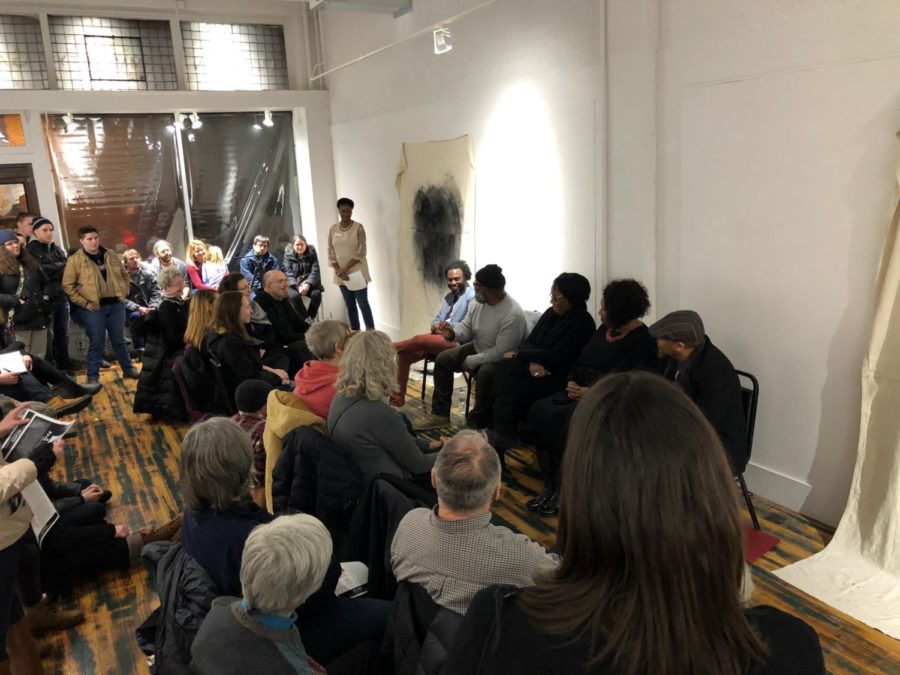Crowds pack Octagon Center for the Arts for “A Negro From the South,” and panel
February 23, 2018
The wet flurry falling from the sky and icing the roads on Thursday night did not deter a crowd from forming at the Octagon Center for the Arts.
According to staff at the Octagon, 85 people crowded into the room. Barren besides a few chairs crowded against a wall and 14 pieces of art on the walls.
The main attraction was Cameron Gray and his exhibition, “A Negro From the South.”
Gray, a graduate student in fine arts and visual culture, has started an important conversation with his art. It’s a conversation Ames needs and clearly wants, according to Gray and the panelists who gathered to discuss people of color in the arts.
The panelists included Mitchell Squire, professor of architecture, Eulanda Sanders, professor and chair of apparel, events and hospitality management, Brenda Jones, professor of art and visual culture, Reginald Stewart, vice president for diversity and inclusion, and Gray.
Diversity and inclusion have been prominent topics at Iowa State in recent years.
“I’ve watched Iowa State grow, and I’ve watched it go backwards sometimes,” Jones said.
For the panelists, one experience was common among all of them. It’s startling to show up in a town as a black person and see no one that looks similar.
While some of the panelists came from areas that were racially and culturally diverse, not everyone was immediately prepared to have tough conversations when arriving in Ames. Stewart, however, said coming from Oakland, California, these conversations were common and he felt like a “fish in water.”
“When I first arrived, I was surprised that people weren’t talking about diversity,” Sanders said.
Stewart said people have been raised on what he calls “polite company,” where people are taught to avoid topics of diversity. When these topics come up, people become uncomfortable.
This is why Gray’s artwork has played a role in unbarring the dialogue of race, panelists said. Opening these topics up through art can make them more easily digestible.
“If you’re not an artist you can listen to it, and if you are an artist you can relate to it,” Stewart said.
However, the lack of racial diversity on campus almost sent Gray running when he arrived in the fall. It was Jones who convinced him to stay at Iowa State, despite the predominantly white campus. Gray said Jones stressed how much Iowa State needed a person like him − an unapologetic black man with “radical” art.
In his exhibition are a series of seven “voids,” drop cloths covered in a mixture of charcoal and chalk.
His voids represent the notion that a black person must be seen but not heard and that black people are seen for their features, but not their complete beings. The eyes, ears and noses that emblazon voids four through seven are the features of his brother, sister, aunt and uncle. These voids were spaciously arranged around the walls in the main room for the audience.
Voids eight through 10 are much more personal to Gray.
He calls them the “Holy Trinity.” These three drop cloths hang in a small, intimate hallway, which Gray dubs “his space.” They depict his own facial features − eyes, nose and mouth − along with the features of his parents. He has come to the conclusion that people look at a black person and see them physically but not spiritually.
He showcases this in his “Jordan Series.” Three canvases hang high along one wall, each displaying the infamous “Air Jordan” silhouette. Gray said the glory of Michael Jordan is in the men and women whose lives were taken in the transatlantic slave trade. Each Jordan canvas showcases a different aspect of the slave trade: Amistad, nooses and cotton.
“We can’t talk about the greatness of this man without including those stories too,” Gray said.
Panelists felt the black community is continually underrepresented in today’s media. The recent release of the critically-acclaimed movie “Black Panther” has brought supporters to theaters in droves. The reception has been record-breaking. It has the second highest grossing four-day release of all time in the United States.
It’s a culturally important movie − directed by a black man and starring an entire cast of black people. Sanders believes the movie will cause an increase in clothing made of African textiles in the near future, based on how popular they were at showings of the film.
“I believe that textiles, clothing, apparel all can be activism,” she said, noting consumers have the power to choose what they buy and whom they buy from.
Another black artist has made headlines recently. Kehinde Wiley and Amy Sherald, who painted Barack and Michelle Obama’s presidential portraits respectively, have been praised and criticized for their work.
“I feel like especially Kehinde’s portrait, it encompasses the black spirit and the beauty of the black body and the beauty of our culture in essence,” Gray said.
It is the same concept Squire wants to showcase in his own work.
“I’m trying to make the culture that I want to be in,” he said. He explained that there are many stereotypes for black men like a gangster or a preacher, but he has his own path in life that doesn’t involve being any of those things.
Jones stated her way of dealing with critics is to “realize you’re not the problem, they are.” Stewart chimed in that having a sense of self-identity and being confident makes it easy to ignore the people who try to tear him down.
Gray expounded on his theory of trying to instill a sense of activism in others in hopes to bring self-awareness as to why their judgments of black culture are off-kilter.
He got an opportunity to do this recently when ordering food at a local restaurant. When asked by the server what was on his sweatshirt, Gray looked down and realized he was wearing his confederate flag pin.
“When I look in the mirror every single day, I want to know what I’m fighting for,” Gray said, adding he wants the symbol to be forgotten because it has become meaningless.
It’s through activism that change is happening, the panelists said. By opening the dialogue of equal rights, the voices of minorities are able to speak up. Even in the span of the past ten years, Sanders said her mother has seen things happen at 75 she “never envisioned would happen in her lifetime.”
This discourse doesn’t always have to be held in the political arena, however. As Gray’s artwork goes to show, the conversation can be carried through multiple platforms like art.
Gray calls his work a form of protest. He analogizes working in the studio to putting on his marching boots. He’s here to make a point with his art and he’s not restraining himself.
“I’m not going to hold my punches. I want to give you the rawness of my truth,” he said.
As for where to take things from here, he told listeners at the panel, “Let’s continue that aspect of always encouraging these voices to be heard and never be silent.”
His message resonated with his audience. After the panel, hugs were exchanged, smiles and laughs were shared. Gray was beaming as he was showered with praise. It was finally starting to sink in for him, and he called it “surreal.”
Family and friends, students and peers all came out to support the artist. Those who couldn’t squeeze a word in with the man of the hour weren’t disappointed. His work did sufficient speaking for him. As the room cleared out, Gray spent a few final moments in “his space,” soaking it all in, before walking out into the night as dark as his voids.
















